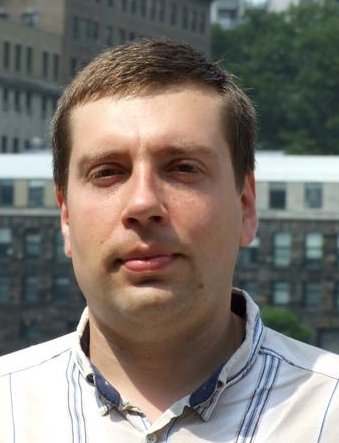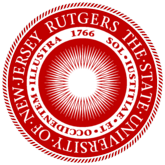
Professor Director
Department of Physics & Astronomy
Rutgers University
136 Frelinghuysen Rd.
Piscataway, NJ 08854-8019 U.S.A.
Center for Quantitative Biology
| Office: | Serin E266 |
| Phone: | 848-445-1387 |
| Email: | morozov at physics dot rutgers dot edu |

Research Description:
My current research efforts focus on a number of topics in biological physics. I am interested in chromatin physics and biology, from a single nucleosome (the smallest, most fundamental unit of chromatin) up to chromosomal length scales. Another major area of interest in my group is evolutionary theory and population genetics, with the emphasis on evolution of proteins and protein complexes and co-evolution of DNA-binding factors and their cognate sites. I am also fascinated by the physics of protein-DNA recognition: how does a transcription factor find its sites robustly and specifically genome-wide? Finally, since many processes in biology occur out-of-equilibrium, I am interested in the general theory of non-equilibrium processes, and especially in non-equilibrium dynamics and global optimization on networks, fitness landscapes, and protein folding landscapes. In the past, I have also contributed to developing methods and algorithms for predicting protein structures from amino acid sequences, predicting kinetics of protein folding, analyzing mechanisms of molecular recognition, and predicting binding affinities and specificities of protein-protein interactions.- Studies of chromatin structure and its effect on gene regulation
(both nucleosome positioning and higher-order structure).
In eukaryotic genomes, nucleosomes (histone octamer-DNA complexes) function to compact DNA and to regulate access to it both by simple physical occlusion and by providing the substrate for numerous covalent epigenetic tags. My group uses sequence-dependent DNA mechanics models as well as techniques borrowed from statistical mechanics and polymer physics in order to study chromatin structure both in vitro, where it is determined solely by DNA sequence and steric exclusion between neighboring nucleosome particles, and in vivo, where it may be affected by the competition with other DNA-binding factors, the action of chromatin remodeling enzymes, and folding into higher-order structures. Our computational models are guided by high-throughput maps of nucleosomes, transcription factors and other macromolecular machines in cells from various model organisms that are subjected to a range of environmental stresses and growth conditions. We also study spatiotemporal dynamics of transcription factors activated by stress. The ultimate goal of this research is to predict eukaryotic gene regulation on a whole-genome scale, including the variation that is influenced by cell type, environmental signals, developmental stage, and disease state. Broadly speaking, I seek to improve our current understanding of the "transcriptional and post-transcriptional regulatory code" that links the DNA sequence with gene expression levels. - Mechanisms of molecular evolution.
Amino acid and nucleic acid substitutions that have accumulated in homologous proteins and in genomic DNA in the course of natural evolution and in in vitro evolutionary experiments provide important clues to their function. We are developing theoretical models of molecular evolution on arbitrary fitness landscapes, and studying fundamental physical constraints imposed on evolutionary dynamics and accessible evolutionary trajectories. - Prediction of protein-DNA energetics (amino acid - DNA basepair recognition code).
We are constructing thermodynamic models of protein-DNA recognition using a combination of protein-DNA structural data and high-throughput methods designed to probe protein-DNA interactions on the genomic scale. - Non-equilibrium dynamics and optimization on multi-dimensional landscapes.
The notion of a multi-dimensional landscape plays a central role in many scientific fields. In evolutionary biology fitness landscapes are used to ascribe reproductive success, or fitness, to evolving organisms (or, on a molecular level, to evolving genes and regulatory sequences). Protein folding can be viewed as a search on a complex landscape in which each macromolecular conformation is assigned a sequence-specific free energy. The landscape view is also routinely employed in the studies of chemical reactions. I am interested in computational and theoretical studies of kinetics on rugged landscapes and their application to protein folding, molecular evolution, and chemical kinetics. - Detection of chemicals and mixtures of chemicals with sensor arrays.
We are interested in fundamental principles behind mammalian and insect olfactory systems. Better knowledge of such systems will enable us to construct combinatorial arrays of biological and solid-state sensors tailored for precise measurements of various components in the unknown mixtures applied to the arrays, such as harmful gases in diesel exhaust. We are analyzing array readouts using customized Bayesian algorithms based on the models of physical interactions between sensors and the chemicals of interest.
Websites:
Courses:
- 16:750:567/16:118:507 Physics of Living Matter (Spring 2008)
- 16:750:567/16:118:507 Physics of Living Matter (Spring 2009)
- 16:750:567/16:118:507 Physics of Living Matter (Spring 2010)
- 16:750:406 Introducton to Solid State Physics (Spring 2011)
- 16:750:406 Introducton to Solid State Physics (Spring 2012)
- 16:750:406 Introducton to Solid State Physics (Spring 2013)
- 16:750:504 Electricity & Magnetism II (Spring 2015)
- 16:750:504 Electricity & Magnetism II (Spring 2016)
- 16:750:504 Electricity & Magnetism II (Spring 2017)
- 16:750:504 Electricity & Magnetism II (Spring 2018)
- 16:750:313 Introduction to Modern Physics (Fall 2015)
- 16:750:677 Advanced Topics in Statistical and Biological Physics (Fall 2016)
- 16:750:677 Advanced Topics in Statistical and Biological Physics (Fall 2017)
- 16:750:677 Advanced Topics in Statistical and Biological Physics (Fall 2018)
- 16:750:568 Large-scale data analysis in Physics & Astronomy (Spring 2019)
- 16:750:568 Large-scale data analysis in Physics & Astronomy (Spring 2020)
- 16:750:568 Large-scale data analysis in Physics & Astronomy (Spring 2022)
- 16:750:568 Large-scale data analysis in Physics & Astronomy (Spring 2023)
- 16:750:568 Large-scale data analysis in Physics & Astronomy (Fall 2024)
- 16:750:507 Classical Mechanics (Fall 2019)
- 16:750:507 Classical Mechanics (Fall 2021)
- 16:750:507 Classical Mechanics (Fall 2022)
- 16:750:677 Advanced Topics in Statistical and Biological Physics (Fall 2023)
- 16:750:611 Statistical Mechanics (Spring 2024)
- 16:750:611 Statistical Mechanics (Spring 2025)
- 16:750:677 Advanced Topics in Statistical and Biological Physics (Fall 2025)